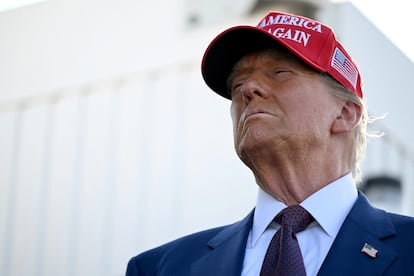The red lines the market won’t let Donald Trump cross
Big investors are enjoying a stock market at an all-time high, driven by the tycoon’s victory. However, they are beginning to become suspicious of his costly proposals, which would drive up inflation and harm the millions of retail investors who voted for him

Donald Trump will return to the White House on January 20 after winning a landslide with his slogans: “American First” and “Make America Great Again.” However, such an objective — the epicenter of the populist ideology that led him to a second term — doesn’t match a strong stock market. Nor does it make Wall Street happy.
Trump inherits a solid economy from Biden, as well as a stock market at an all-time high. Technology stocks, for instance, are at dizzying levels. Yet Trump has launched proposals that are beginning to create concern among investors. These are the same people who, in November 2024, welcomed his electoral victory with a wave of purchases. But from now on, they’ll have to be very attentive to the implementation of the Republican’s economic policy. And there will also be those who don’t hesitate to put limits on any measures that may upset Wall Street, even if they come from a billionaire businessman president, who’s being advised by the richest man in the world.
Trump is starting off with the market’s support, which initially expects tax cuts and deregulation to continue to fuel the stock market. But investors will have no qualms about hitting the “sell” button if presidential policies puncture the long stock market rally. And there will also be millions of private investors — voters, after all — whose financial savings will be subject to the ups and downs of their president’s decisions, beyond the havoc that a new surge in inflation could cause in households. In the U.S., financial culture and investment in the stock market are much more widespread among the general population than in Europe or Canada.
Trump has flirted with radical proposals, such as a 60% tariff on the import of Chinese products, a 10% tariff on all imports in general, and the massive repatriation of undocumented immigrants. All of these measures would lead to an increase in wages and the price of consumer goods, which would threaten to reactivate inflation. “The citizens of the United States have given victory to two billionaires who support measures that will make the products they buy more expensive,” summed up Olivier de Berranger — CEO of the asset manager LFDE — shortly after the elections. He was referring to Trump and his right-hand man, Elon Musk.
Trump’s new mandate entails an inflationary risk that the market is reluctant to openly acknowledge, although it has begun to feel its way out. This is demonstrated by the S&P 500 losing almost 3% since December 17, 2024 — the last day on which it closed above 6,000 points, a milestone achieved for the first time after Trump’s electoral victory — or the U.S. 10-year bond raising its yield to the brink of 4.7%, gaining almost 50 basis points in the last month.
“If tariffs are implemented rapidly and in line with campaign rhetoric, part of the impact would be absorbed via currency depreciation, but there would likely be a substantial impact on U.S. inflation, which would disproportionately affect lower income households, a key element of Trump’s support base,” writes Tom Wilson, head of Emerging Market Equities at Schroders.
The administration that begins on January 20 is expected to be unpredictable and volatile (like the new president’s character). However, analysts and fund managers agree that campaign proposals will be largely toned down when it comes to their implementation. After all, Trump’s business and investment side is also expected to emerge: he will want to strike the most profitable trade deals possible, without breaking the bank.
An example of what is assumed to be Trump’s investor pragmatism (albeit wrapped in a consistent populist rhetoric) happened this past week. The Washington Post published that the incoming Republican president is considering a universal tariff on imports from all countries, although focused only on critical and strategic products. According to the newspaper, this would tone down “the most radical element of Trump’s campaign plan.” The tycoon flatly denied the information, but the market also understands that his tariff threat is part of a negotiating stance from the start. “[Trump] wants the threat of universal tariffs as credible leverage into bilateral trade negotiations… taking this off the table would obviously limit his bargaining power,” reads a post by UBS Insights.
The Chief Investment Office of UBS agrees with those who believe that the economic measures proposed during the election campaign won’t materialize in full: “We doubt the administration will pursue the kinds of extreme policies that would send inflation higher, create major supply disruptions, or risk broader economic fallout. There is also a political calculation here, with the Republican House majority already extremely thin. A ‘shock therapy’ approach could significantly harm Republican chances in the 2026 midterms.”
The Fed’s warning
Trump’s inflationary threat isn’t trivial. It’s the red line that his policy won’t be able to cross without causing serious repercussions in the economy and the investment world. And any decision will have to be very measured as price tensions persist, amid an economy that gives off continuous signs of strength. On top of this — even before Trump has come to power — the Federal Reserve is projecting just two interest rate cuts in 2025. “The Fed is cutting its outlook for this year. What’s not clear is whether this is due to a worsening of the inflation forecast, or a lack of confidence in Trump’s economic policy,” says Alexis Bienvenu, fund manager at Financière de l’Échiquier.
In November 2024, the monthly rise in prices in the U.S. was 0.3% — the highest since April — and the interannual rate stood at 2.7%. Inflation already picked up in October, rising to 2.6%, following six months of decline. And, this past week, it was revealed that the number of job offers rose in November to 8.1 million, the highest level in six months. This was above expectations and also above the October figure of 7.8 million. Additionally, the PMI Index for the services sector recorded the largest increase since 2023, up to 54.1 points, revealing the expansion of this activity.
“We expect GDP to grow by 2.8% in 2024 [using year-end data] and by 2.4% in 2025, if the new administration prioritizes tax cuts over tariffs. This forecast assumes that the new Trump administration will start with tax cuts and leave the implementation of less growth-friendly measures — such as tariffs — for the second-half of next year. This would reduce risk,” explains Paolo Zanghieri, senior economist at Generali AM. Once again, forecasts are expecting a toned-down application of Trump’s electoral promises, which is key to ensuring continued growth.
The Federal Reserve has already significantly cooled the mood by lowering expectations of interest rate cuts. Pimco — the world’s largest fixed-income fund management firm — has calculated what would have to happen during Trump’s term in office for Fed Chairman Jerome Powell to be forced to raise interest rates. For instance, if Trump were to apply the maximum level of tariffs that he’s been preaching — 60% on products imported from China and 10% on all other imports — core CPI inflation (which includes both services and goods) would end up rising to a range of 4.0%-4.5%. Pimco believes that such a scenario is unlikely, but were it to occur, the Fed would be forced to tighten up its monetary policy.
Fears of a spike in inflation are weighing on investors and have contributed to the rise in yields on U.S. debt. The market is also keeping in mind that the U.S. economy is already suffering from a high public deficit — more than 6% of GDP — which could also increase with Trump’s policies. An increase in bond yields will further increase the interest burden borne by the U.S., whose total debt amounts to nearly $28 trillion and represents almost 100% of GDP.
Bank of America believes that the volume of U.S. debt will continue to grow and that the deficit outlook will remain high, unless there are significant spending cuts or an increase in revenue. “Economic and market risks are increasing, but in our opinion, they’re manageable for now,” analysts at Bank of America note. They also warn that a 10-year U.S. bond offering 5% returns would encourage investors to abandon equities and take refuge in fixed income.
Despite the fact that the United States is the world’s largest economy and the U.S. dollar is the global currency, Trump will still have to be careful with the mood of U.S. bondholders and not venture into policies that take the country too far away from fiscal consolidation. The United Kingdom is currently experiencing a rapid rise in the interest rate on its bonds, partly due to the resilience of inflation and partly also due to a certain investor distrust of the Labour government.
This rise echoes the severe reaction that the market had in 2022 to the fiscally irresponsible tax cut plan of Liz Truss, which cost her the position of prime minister. That episode — which resulted in a sudden loss of credibility in the British public debt — forced the Bank of England to intervene. This was in view of the fact that the powerful British pension plan industry — equivalent to 100% of the country’s GDP — was at risk. In the United States, pension plan assets are around 150% of GDP, meaning that there’s far too much money at stake for Trump to anger Wall Street.
Sign up for our weekly newsletter to get more English-language news coverage from EL PAÍS USA Edition
Tu suscripción se está usando en otro dispositivo
¿Quieres añadir otro usuario a tu suscripción?
Si continúas leyendo en este dispositivo, no se podrá leer en el otro.
FlechaTu suscripción se está usando en otro dispositivo y solo puedes acceder a EL PAÍS desde un dispositivo a la vez.
Si quieres compartir tu cuenta, cambia tu suscripción a la modalidad Premium, así podrás añadir otro usuario. Cada uno accederá con su propia cuenta de email, lo que os permitirá personalizar vuestra experiencia en EL PAÍS.
¿Tienes una suscripción de empresa? Accede aquí para contratar más cuentas.
En el caso de no saber quién está usando tu cuenta, te recomendamos cambiar tu contraseña aquí.
Si decides continuar compartiendo tu cuenta, este mensaje se mostrará en tu dispositivo y en el de la otra persona que está usando tu cuenta de forma indefinida, afectando a tu experiencia de lectura. Puedes consultar aquí los términos y condiciones de la suscripción digital.











































